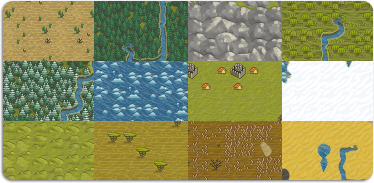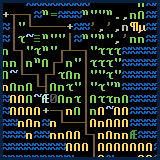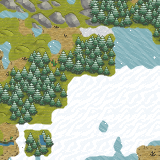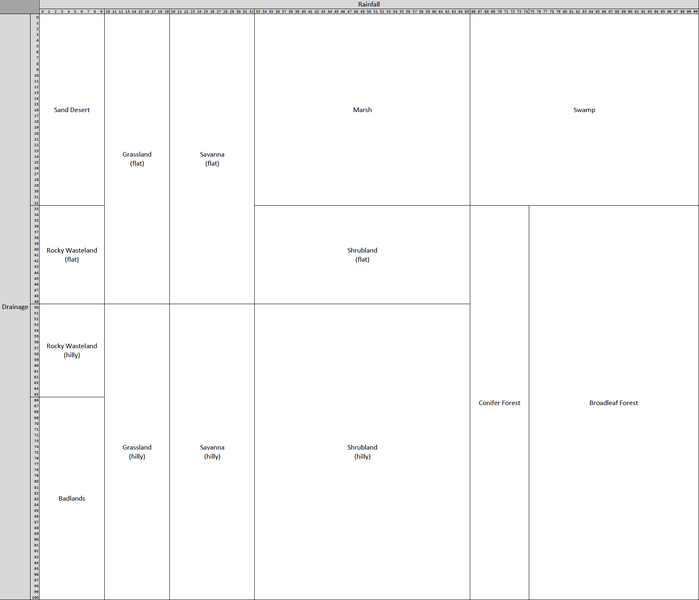- v50 information can now be added to pages in the main namespace. v0.47 information can still be found in the DF2014 namespace. See here for more details on the new versioning policy.
- Use this page to report any issues related to the migration.
Difference between revisions of "Biome"
(→Deserts: Added link to the Desert article the section title) |
(→Underground: these are determined by the CAVERN_LAYER_WATER_MIN/CAVERN_LAYER_WATER_MAX worldgen settings) |
||
| (27 intermediate revisions by 12 users not shown) | |||
| Line 1: | Line 1: | ||
| − | {{Quality|Exceptional| | + | {{Quality|Exceptional|21:26, 17 February 2023 (CST)}} |
{{av}} | {{av}} | ||
| − | A '''biome''' is a biotic area with homogeneous features, characterized by distinctive [[plant]]s, [[creatures|animal species]] and [[climate]]. A biome will also contain only one set of stone | + | [[File:v50_biome_collage.png|right]]A '''biome''' is a biotic area with homogeneous features, characterized by distinctive [[plant]]s, [[creatures|animal species]] and [[climate]]. A biome will also contain only one set of [[stone layer]]s, though these usually expand beyond a single biome. Your [[dwarves]] will find different resources depending on which biomes you select when starting a fort. |
== Selecting a biome == | == Selecting a biome == | ||
| − | + | [[File:biome_view.png|thumb|160px|right|An upper grassy biome, and a lower desert one. ASCII mode.]][[File:biome_view_v50.png|thumb|160px|right|A very cold biome in the north.]]Biomes are important when choosing a fortress location in order to understand your [[surroundings]]. Currently, to check which biomes are in a potential embark, the player needs to move the mouse pointer over each tile. | |
| − | Biomes are important when choosing a fortress location in order to understand your [[surroundings]]. | ||
== Characteristics of biomes == | == Characteristics of biomes == | ||
| − | |||
Selecting different biomes gives you some ability to influence the difficulty of your game. Each biome has a different set of resources; the availability of [[tree]]s, [[sand]], certain [[plant]]s or [[animal]]s, and sometimes [[water]] is specific to a particular biome, and different biomes may have different stone layers containing [[flux]], [[Fuel|coal]] or useful [[ore]]s. [[Mountain]]s have a lot of [[ore]], but no [[soil]]. | Selecting different biomes gives you some ability to influence the difficulty of your game. Each biome has a different set of resources; the availability of [[tree]]s, [[sand]], certain [[plant]]s or [[animal]]s, and sometimes [[water]] is specific to a particular biome, and different biomes may have different stone layers containing [[flux]], [[Fuel|coal]] or useful [[ore]]s. [[Mountain]]s have a lot of [[ore]], but no [[soil]]. | ||
Generally it is advantageous to plot your embark [[location]] at the convergence of multiple different biomes, the more the better (within reason) - which is made easier if you enlarge your starting embarkation area. However, it is not usually too hard to find three or four biomes using the default size. | Generally it is advantageous to plot your embark [[location]] at the convergence of multiple different biomes, the more the better (within reason) - which is made easier if you enlarge your starting embarkation area. However, it is not usually too hard to find three or four biomes using the default size. | ||
| − | ''Note: Making the starting plot larger will slow your game down considerably; likewise, a small embark area can dramatically increase framerate. One embark square translates to | + | ''Note: Making the starting plot larger will slow your game down considerably; likewise, a small embark area can dramatically increase framerate. One embark square translates to 48×48 ingame tiles'' |
| − | By making use of several biomes you can provide more resources for your fort. Making sure one of your biomes contains either a broadleaf or conifer [[forest]] will provide you with an ample supply of [[tree]]s, even if the rest of your plot extends into badlands and [[desert]]. | + | By making use of several biomes, you can provide more resources for your fort. Making sure one of your biomes contains either a broadleaf or conifer [[forest]] will provide you with an ample supply of [[tree]]s, even if the rest of your plot extends into badlands and [[desert]]. |
| − | All biomes also have some kind of "alignment" -- good, neutral, or evil -- and a degree of "savagery", which essentially measures how relatively peaceful the biome is. The combination of alignment and savagery is referred to as the biome's | + | All biomes also have some kind of "alignment" -- good, neutral, or evil -- and a degree of "savagery", which essentially measures how relatively peaceful the biome is. The combination of alignment and savagery is referred to as the biome's [[surroundings]]. However, a named region (which is a contiguous area of one category of biomes, such as [[forest]]s or [[wetland]]s) will be either good, neutral, or evil. It is not uncommon to see a large mountain range with one alignment, and a few mountains, disconnected from the main mountain range by a single region tile, with a different alignment. Therefore, the more biomes you have, the more likely it is to have combinations of different alignments and savageries, if so desired. |
| − | If your plot contains only [[ocean]], [[lake]] or [[mountain]] biomes you will not be able to embark | + | If your plot contains only [[ocean]], [[lake]], or [[mountain]] biomes, you will not be able to embark (the dwarves would have difficulty parking their [[wagon (embark)|wagon]] on water, while mountains are too barren and remote to reach). |
== Available Biomes == | == Available Biomes == | ||
| + | === [[Wetland]]s === | ||
| + | Wetlands may be [[Swamp]] or [[Marsh]]; may be Freshwater or Saltwater; and may be [[temperate]] or [[tropical]]. In addition, there are [[mangrove]] swamps. | ||
| − | === | + | === [[Forest]]s === |
| − | |||
| − | |||
| − | |||
*[[Taiga]] | *[[Taiga]] | ||
*[[Temperate]] [[Coniferous forest|Coniferous Forest]] | *[[Temperate]] [[Coniferous forest|Coniferous Forest]] | ||
*[[Temperate]] [[Broadleaf forest|Broadleaf Forest]] | *[[Temperate]] [[Broadleaf forest|Broadleaf Forest]] | ||
*[[Tropical]] Coniferous Forest | *[[Tropical]] Coniferous Forest | ||
| − | *[[Tropical]] Dry Broadleaf Forest | + | *[[Tropical]] Dry Broadleaf Forest (* due a bug, only generates in worlds with poles of a Medium or Large size) |
*[[Tropical]] Moist Broadleaf Forest | *[[Tropical]] Moist Broadleaf Forest | ||
=== Plains === | === Plains === | ||
| − | Plains include [[ | + | Plains include [[grassland]], [[savanna]] and [[shrubland]]; they may be either [[temperate]] or [[tropical]]. |
=== [[Desert]]s === | === [[Desert]]s === | ||
| − | + | Desert biomes are the driest of all the biomes with sparse to no vegetation. There are three varieties of deserts: '''Badlands''', '''Rocky Wasteland''', and '''Sand Desert''' characterized by very little arable land, stony plains and billowing sand dunes. Deserts can be hot, or quite cold. | |
| − | |||
| − | |||
=== [[Ocean]]s === | === [[Ocean]]s === | ||
| − | + | An expansive body of salt water. There are three varieties of oceans, based on temperature: Arctic, Temperate and Tropical. | |
| − | |||
| − | |||
=== Murky [[Pool]]s === | === Murky [[Pool]]s === | ||
| − | These include Freshwater, Saltwater and Brackish | + | These include Freshwater, Saltwater and Brackish pools, which may be either temperate or tropical. |
=== [[Lake]]s === | === [[Lake]]s === | ||
| − | Like pools, these may be Freshwater, Saltwater or Brackish | + | Like pools, these may be Freshwater, Saltwater or Brackish lakes, and may be either temperate or tropical. |
=== [[River]]s === | === [[River]]s === | ||
| − | Like pools and lakes, these may be Freshwater, Saltwater or Brackish | + | Like pools and lakes, these may be Freshwater, Saltwater or Brackish rivers, and may be either temperate or tropical. |
=== Underground === | === Underground === | ||
| − | * Subterranean Water | + | * Subterranean Water (a [[cavern]] whose [[Advanced world generation#Layer Water min/max|water level]] is 10% or higher) |
| − | * Subterranean Chasm | + | * Subterranean Chasm (a [[cavern]] whose water level is 90% or lower) |
| − | * Subterranean | + | * Subterranean Lava (the [[magma sea]]) |
=== Other === | === Other === | ||
| Line 70: | Line 63: | ||
Certain creatures and plants use special biome tokens to encompass several similar environments. | Certain creatures and plants use special biome tokens to encompass several similar environments. | ||
| − | * " | + | * "{{token|NOT_FREEZING|biome}}" includes all land biomes except Mountains, Glaciers, and Tundras. All plants require a "Not Freezing" biome (or a more specific biome group); you will be unable to grow any aboveground crops at all in a Mountain biome. |
* "Any Temperate Broadleaf" includes temperate broadleaf forests as well as grasslands, savannas, shrublands, swamps, and marshes. | * "Any Temperate Broadleaf" includes temperate broadleaf forests as well as grasslands, savannas, shrublands, swamps, and marshes. | ||
* "Any Tropical Broadleaf" includes tropical dry/moist broadleaf forests as well as grasslands, savannas, shrublands, swamps (including Mangrove), and marshes. | * "Any Tropical Broadleaf" includes tropical dry/moist broadleaf forests as well as grasslands, savannas, shrublands, swamps (including Mangrove), and marshes. | ||
| Line 77: | Line 70: | ||
== Generating a Biome == | == Generating a Biome == | ||
| − | |||
When using [[advanced world generation]] or [[world painter]] to attempt to create the "perfect" starting location, it helps to understand how biomes are created. Biomes are calculated for each region tile (the center map when choosing an embark), then noise is calculated and applied which causes the irregular region boundaries on the local map. For the most part, a region's biome is a factor of elevation, drainage, rainfall, and temperature, as explained in [http://www.bay12forums.com/smf/index.php?topic=20685.0 this old forum thread for 40d]. | When using [[advanced world generation]] or [[world painter]] to attempt to create the "perfect" starting location, it helps to understand how biomes are created. Biomes are calculated for each region tile (the center map when choosing an embark), then noise is calculated and applied which causes the irregular region boundaries on the local map. For the most part, a region's biome is a factor of elevation, drainage, rainfall, and temperature, as explained in [http://www.bay12forums.com/smf/index.php?topic=20685.0 this old forum thread for 40d]. | ||
| Line 84: | Line 76: | ||
[[Image:DF_Biome_Distribution.png|699px|thumb|none]] | [[Image:DF_Biome_Distribution.png|699px|thumb|none]] | ||
| − | All other biomes are variations on the corresponding base biome shown above. For example, salinity determines the type of lake, swamp, and marsh. A salinity of 0 is a freshwater biome, 33 is a freshwater swamp or marsh but a brackish lake, 66 is a saltwater biome, and 100 is an ocean. Temperature determines tropical and frozen variants. Region tile temperatures at or below -5 convert all base biomes with drainage below 75 to Tundra, and biomes with drainage 75+ to Glaciers. Similarly, Arctic Oceans replace Temperate Oceans. Between -4 and 9 (inclusive) Conifer Forests become Taiga. At the other end of the temperature scale, biomes become tropical at around 85+; generally speaking you'll need Hot and Scorching temperatures. Tropical Saltwater Swamps are converted to Mangrove Swamps when drainage is 9 or less. Unfortunately, temperature is harder to affect directly in world gen because, according to Toady One, it's affected by | + | All other biomes are variations on the corresponding base biome shown above. For example, salinity determines the type of lake, swamp, and marsh. A salinity of 0 is a freshwater biome, 33 is a freshwater swamp or marsh but a brackish lake, 66 is a saltwater biome, and 100 is an ocean. Temperature determines tropical and frozen variants. Region tile temperatures at or below -5 convert all base biomes with drainage below 75 to Tundra, and biomes with drainage 75+ to Glaciers. Similarly, Arctic Oceans replace Temperate Oceans. Between -4 and 9 (inclusive) Conifer Forests become Taiga. At the other end of the temperature scale, biomes become tropical at around 85+; generally speaking you'll need Hot and Scorching temperatures. Tropical Saltwater Swamps are converted to Mangrove Swamps when drainage is 9 or less. Unfortunately, temperature is harder to affect directly in world gen because, according to Toady One, it's affected by latitude, elevation, and moisture. Additionally, when the pole setting is none, the tropical or frozen biome variants do not respect the otherwise static divisions. |
== Bugs == | == Bugs == | ||
Latest revision as of 16:48, 26 October 2025
v53.06 · v0.47.05 This article is about the current version of DF.Note that some content may still need to be updated. |
A biome is a biotic area with homogeneous features, characterized by distinctive plants, animal species and climate. A biome will also contain only one set of stone layers, though these usually expand beyond a single biome. Your dwarves will find different resources depending on which biomes you select when starting a fort.
Selecting a biome[edit]
Biomes are important when choosing a fortress location in order to understand your surroundings. Currently, to check which biomes are in a potential embark, the player needs to move the mouse pointer over each tile.
Characteristics of biomes[edit]
Selecting different biomes gives you some ability to influence the difficulty of your game. Each biome has a different set of resources; the availability of trees, sand, certain plants or animals, and sometimes water is specific to a particular biome, and different biomes may have different stone layers containing flux, coal or useful ores. Mountains have a lot of ore, but no soil.
Generally it is advantageous to plot your embark location at the convergence of multiple different biomes, the more the better (within reason) - which is made easier if you enlarge your starting embarkation area. However, it is not usually too hard to find three or four biomes using the default size.
Note: Making the starting plot larger will slow your game down considerably; likewise, a small embark area can dramatically increase framerate. One embark square translates to 48×48 ingame tiles
By making use of several biomes, you can provide more resources for your fort. Making sure one of your biomes contains either a broadleaf or conifer forest will provide you with an ample supply of trees, even if the rest of your plot extends into badlands and desert.
All biomes also have some kind of "alignment" -- good, neutral, or evil -- and a degree of "savagery", which essentially measures how relatively peaceful the biome is. The combination of alignment and savagery is referred to as the biome's surroundings. However, a named region (which is a contiguous area of one category of biomes, such as forests or wetlands) will be either good, neutral, or evil. It is not uncommon to see a large mountain range with one alignment, and a few mountains, disconnected from the main mountain range by a single region tile, with a different alignment. Therefore, the more biomes you have, the more likely it is to have combinations of different alignments and savageries, if so desired.
If your plot contains only ocean, lake, or mountain biomes, you will not be able to embark (the dwarves would have difficulty parking their wagon on water, while mountains are too barren and remote to reach).
Available Biomes[edit]
Wetlands[edit]
Wetlands may be Swamp or Marsh; may be Freshwater or Saltwater; and may be temperate or tropical. In addition, there are mangrove swamps.
Forests[edit]
- Taiga
- Temperate Coniferous Forest
- Temperate Broadleaf Forest
- Tropical Coniferous Forest
- Tropical Dry Broadleaf Forest (* due a bug, only generates in worlds with poles of a Medium or Large size)
- Tropical Moist Broadleaf Forest
Plains[edit]
Plains include grassland, savanna and shrubland; they may be either temperate or tropical.
Deserts[edit]
Desert biomes are the driest of all the biomes with sparse to no vegetation. There are three varieties of deserts: Badlands, Rocky Wasteland, and Sand Desert characterized by very little arable land, stony plains and billowing sand dunes. Deserts can be hot, or quite cold.
Oceans[edit]
An expansive body of salt water. There are three varieties of oceans, based on temperature: Arctic, Temperate and Tropical.
Murky Pools[edit]
These include Freshwater, Saltwater and Brackish pools, which may be either temperate or tropical.
Lakes[edit]
Like pools, these may be Freshwater, Saltwater or Brackish lakes, and may be either temperate or tropical.
Rivers[edit]
Like pools and lakes, these may be Freshwater, Saltwater or Brackish rivers, and may be either temperate or tropical.
Underground[edit]
- Subterranean Water (a cavern whose water level is 10% or higher)
- Subterranean Chasm (a cavern whose water level is 90% or lower)
- Subterranean Lava (the magma sea)
Other[edit]
Groups[edit]
Certain creatures and plants use special biome tokens to encompass several similar environments.
- "
[NOT_FREEZING]" includes all land biomes except Mountains, Glaciers, and Tundras. All plants require a "Not Freezing" biome (or a more specific biome group); you will be unable to grow any aboveground crops at all in a Mountain biome. - "Any Temperate Broadleaf" includes temperate broadleaf forests as well as grasslands, savannas, shrublands, swamps, and marshes.
- "Any Tropical Broadleaf" includes tropical dry/moist broadleaf forests as well as grasslands, savannas, shrublands, swamps (including Mangrove), and marshes.
More information can be found in the Biome token list.
Generating a Biome[edit]
When using advanced world generation or world painter to attempt to create the "perfect" starting location, it helps to understand how biomes are created. Biomes are calculated for each region tile (the center map when choosing an embark), then noise is calculated and applied which causes the irregular region boundaries on the local map. For the most part, a region's biome is a factor of elevation, drainage, rainfall, and temperature, as explained in this old forum thread for 40d.
When determining the biome, elevation comes first; any terrain with an elevation of 0-99 is ocean, while any terrain with an elevation of 300-400 is mountain. All other biomes lie in between these two extremes. The remaining base biomes are determined by the combination of drainage and rainfall.
All other biomes are variations on the corresponding base biome shown above. For example, salinity determines the type of lake, swamp, and marsh. A salinity of 0 is a freshwater biome, 33 is a freshwater swamp or marsh but a brackish lake, 66 is a saltwater biome, and 100 is an ocean. Temperature determines tropical and frozen variants. Region tile temperatures at or below -5 convert all base biomes with drainage below 75 to Tundra, and biomes with drainage 75+ to Glaciers. Similarly, Arctic Oceans replace Temperate Oceans. Between -4 and 9 (inclusive) Conifer Forests become Taiga. At the other end of the temperature scale, biomes become tropical at around 85+; generally speaking you'll need Hot and Scorching temperatures. Tropical Saltwater Swamps are converted to Mangrove Swamps when drainage is 9 or less. Unfortunately, temperature is harder to affect directly in world gen because, according to Toady One, it's affected by latitude, elevation, and moisture. Additionally, when the pole setting is none, the tropical or frozen biome variants do not respect the otherwise static divisions.
Bugs[edit]
- Different biomes can exist in layers above the surface. This can lead to odd behavior like evil rain above a "good" biome.Bug:8781
Worlds | |||||||||
|---|---|---|---|---|---|---|---|---|---|
| General | |||||||||
| Map |
| ||||||||
| Civilization |
| ||||||||



